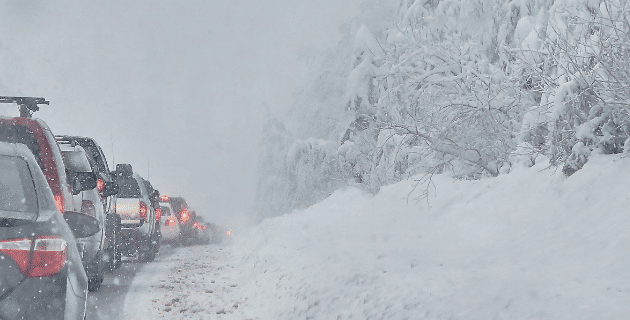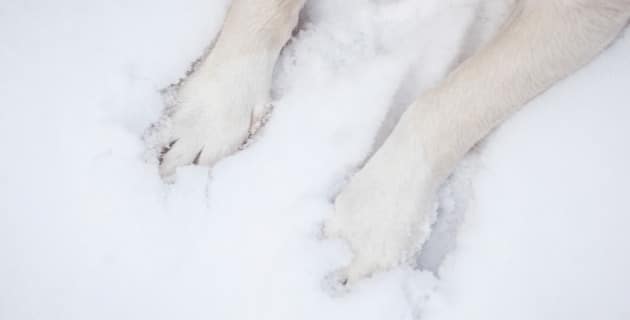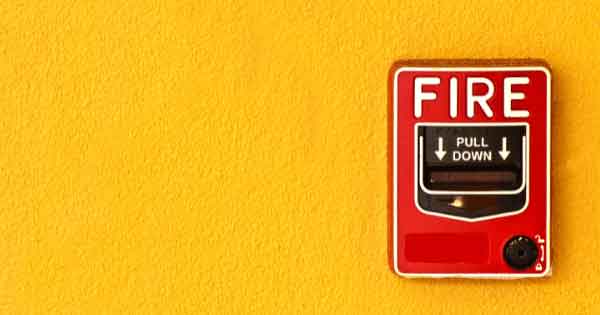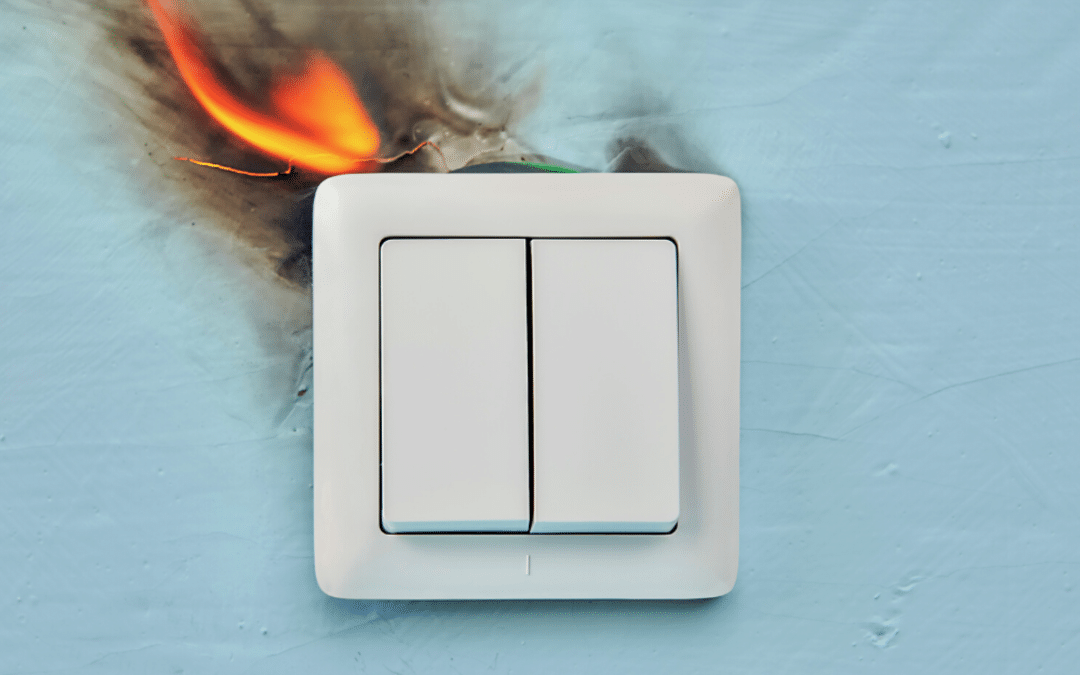
by California Casualty | Auto Insurance Info, Homeowners Insurance Info, Safety |
When the temperatures dip low, wind speeds hit high, and precipitation is in the forecast, you could be in the path of a winter storm. These powerful acts of nature have the potential to cut off power and trap you and your family in your home for days, and that’s not all… Winter storms have also been associated with hypothermia, frostbite, carbon monoxide poisoning, and even heart attacks.
Being well prepared is your best defense. Follow this guide so you can weather winter storms safely.
Know what to expect when
The National Weather Service issues severe weather alerts for winter storms. While the exact amounts of snow vary based on where you live, here are some general definitions.
-
- Winter storm watch – Conditions are right for hazardous winter weather within 48 hours. It doesn’t mean it will occur, but a winter storm is possible.
- Winter storm advisory – Usually issued within 36 hours of an expected storm, an advisory lets you know to anticipate snow, sleet and/or freezing rain.
- Winter storm warning – Expect snow, sleet, ice, freezing rain and/or hazardous winter conditions within the next 12-24 hours.
Get ready
Your primary concerns during a severe winter storm are the loss of heat, power, and communications, having enough food and supplies, and protecting your home from possible storm damage. Stock up on supplies, take protective measures for your home and create a disaster plan to share with everyone in the family. That may include planning for evacuation if needed.
Stock up and charge up- Building your emergency kit.
-
- Stock up on food that requires no cooking or refrigeration. Make sure you have a manual can opener if you’re planning to open cans.
- Include baby food and diapers if needed.
- Buy cases of bottled water to use in case the pipes freeze. You can use this for brushing teeth, flushing toilets, and bathing. Make sure you have at least 3 gallons of water per person. You can also fill the bathtub with water as an extra source.
- Make sure you have enough prescription medications, and any toiletries needed.
- If you have pets, stock up on food for them.
- Gather your flashlights and extra batteries. Collect candles and matches.
- Pull out the battery-powered radio for weather updates. You can also use it to play music to pass the time.
- Make sure you have lots of blankets and warm clothes for each member of the household.
- Charge all of your devices ahead of the storm. Charge any portable battery backups. Determine how you will charge your phone during a power outage.
Protect your home
-
- Make sure your home’s furnace is in good working order.
- Check for drafts and use these winter window hacks to keep your home warm and toasty.
- Know how to turn off your utilities, such as gas lines or water, in an emergency.
- Consider buying emergency heating equipment such as a wood or coal-burning stove or electric or kerosene heater. Review all safety precautions, and be careful of fire hazards when storing fuel.
- Consider installing a portable generator. Review generator safety and never run a generator in an enclosed space.
- Make sure your smoke detector and carbon monoxide detectors are working. If you’ll be using your fireplace or wood stove for heat, they should be near that area. Have a fire extinguisher nearby just in case, or try this way to put out fires without an extinguisher.
- Test your snow blower and have it serviced if necessary.
- Take a walk around your house and identify any trees that could fall. If there’s time, trim them back.
Be prepared to leave if needed
-
- Service your vehicle and make sure you’re prepared for winter. Have a mechanic check your antifreeze, windshield-washer fluid, defroster, wipers, battery, brakes, and tires.
- Keep your car’s gas tank full for emergency use.
- Stock your car with these must-carry items.
- Research local shelters and warming stations in your area in case you need to evacuate your home.
- Prepack a bag for each member of the family, including pets.
Once the Storm Arrives
During the storm…
-
- Limit your time outside. Hypothermia and frostbite are real dangers.
- Do not attempt to travel during treacherous conditions. You could find yourself in an accident or stranded on the road.
- Stay tuned to emergency weather alerts.
- Check on neighbors if they’re older or have young children who are more at risk in extreme cold.
After the storm…
-
- Avoid driving until conditions have improved. Follow winter driving safety guidelines.
- Keep a supply of kitty litter and/or ice melt to clear sidewalks.
- Be careful to not overexert yourself. It’s common for heart attacks to be brought on by overexertion from shoveling or clearing snow.
- Assess any damage to your home or property and alert your insurance company. You have home insurance for a reason. Put it to work if you need it.
This article is furnished by California Casualty, providing auto and home insurance to educators, law enforcement officers, firefighters, and nurses. Get a quote at 1.866.704.8614 or www.calcas.com.

by California Casualty | Pets, Safety |
For many of us, winter weather means it’s time to put down that layer of salt. After all, you don’t want to hurt yourself or be liable if anyone slips on your sidewalk!
Ironically, in your effort to keep everyone safe, you might be endangering the very ones you want to protect. That’s because ice melt is dangerous for pets. And it’s not just the ice melt on your property. Ice melt that is universally used on roadways and walking paths is usually not pet-friendly and can cause serious harm and even death.
Here’s what you need to know to keep your pets safe this snowy season.
Know the chemicals.
Ice melt is made up of chemicals like sodium chloride (the same as table salt) and calcium salts (calcium carbonate, calcium magnesium acetate, and calcium chloride). Sometimes it also contains potassium chloride, magnesium chloride and/or urea (carbonyl diamide). These chemicals lower the freezing point for water, causing the ice to melt and turn to slush. In addition to having an effect on ice, they also cause damage to concrete, cement, soil, and water, as well as plants and animals.
That’s where your pet comes in. It may be tempting for your dog or cat to sniff around at ice melt because of its salty taste. Or they may walk on it and get it on their paws, and then lick it off. But even table salt is dangerous for them in large quantities.
If ingested, ice melt can cause anything from mild indigestion to severe vomiting, diarrhea and dehydration, and even death. Just 4 g/kg of sodium chloride can be deadly, according to the Pet Poison Helpline. According to Pet MD, ethylene glycol-based ice melts contain the same active ingredient as antifreeze. They are deadly if ingested. Calcium chloride also can cause mouth ulcerations and irritation. So, what do you need to look out for in your pet? An abnormally high body temperature, a racing heart, and rapid breathing are all signs of elevated blood sodium levels. Keep reading for more signs and symptoms.
Ice melt is also a skin irritant. It can cause irritation, dryness, and even burns on your fur babies’ paws or between their pads. If they scratch or rub their face, the ice melt can get in their eyes. If a small piece of salt makes its way in between your pet’s pads, it can be highly uncomfortable and have a chance of being swallowed.
If you’re thinking you can just check the package and make sure these ingredients are not listed, think again. Unfortunately, not all ice melt packages provide a full list of ingredients.
Are there any ice melts that are safe for pets?
You can buy ice melts that are labeled ‘safe for pets’, but even these are not completely safe, according to the Pet Poison Helpline. They are simply safer options. If ingested, they can still cause gastric distress. Also, while safe for dogs, ice melt with propylene glycol can be damaging to cats’ red blood cells, according to PetMD.
Products safe for pets usually are urea-based. They are some of the safest options for dogs and cats, but if you have goats or cows, beware. Urea can cause ammonia toxicosis in animals that have that type of digestive tract.
How to Prevent Exposure
An ounce of prevention is worth a pound of cure. Keeping your pet away from dangerous ice melts is your first defense.
-
- Avoid areas that are slushy or where it looks like ice melt has been applied.
- Don’t let pets sniff or eat road salt, ice melt, etc.
- Don’t let pets run and play in an area that looks like it has been treated with ice melt.
- Wipe your pet’s paws with a damp cloth to remove any ice melt as soon as you come in from outside. This way, your fur baby won’t accidentally ingest it when licking his/her paws.
- Store the ice melt package far out of reach of curious pets.
- If you want to protect your fur baby’s paws, consider paw wax or doggie booties.
- Instead of ice melt, try products intended to provide traction, such as sand, gravel, kitty litter, and wood ash.
Watch for these signs and symptoms.
Keep a close eye on your fur baby, If you notice him/her walking gingerly or licking his/her paws, there could be a problem. Also, look for these signs of possible exposure to ice melt:
-
- Skin irritation/burns
- Mouth ulcers
- Increased urination
- Excessive drooling
- Nausea/gastrointestinal upset/vomiting
- Body and muscle weakness
- Seizures
Call your veterinarian right away if you believe your pet has ingested ice melt and is exhibiting symptoms. The ASPCA Animal Poison Control Center also is available 24/7 to answer your questions. A consultation fee may apply.
Pet health insurance can help cover the costs if anything should happen to your fur baby. Make sure you are fully covered in event of an emergency.
This article is furnished by California Casualty, providing auto and home insurance to educators, law enforcement officers, firefighters, and nurses. Get a quote at 1.866.704.8614 or www.calcas.com.

by California Casualty | Educators |
Fire safety comes in many forms- drills, procedures, seminars, dedicated months/weeks, etc. But nothing prepares you for the scare of an unplanned fire alarm, especially when you are in the classroom. No matter what, when you are a teacher, your students are your first priority. It’s the extra effort that you put in as a teacher that ensures everyone stays safe during an emergency, like a fire.
In honor of Fire Safety Month, we wanted to share why and when fires happen in schools, and what else you can do to encourage fire safety.
A Brief History of School Fire Safety
On March 4, 1908, a fire broke out at the Lake View School in Ohio. There was only one staircase in the four-story building with no fire doors or exits. Between the oiled floors and the wood interior, the fire quickly caught and trapped students and staff inside, ultimately killing 172 students, 2 teachers, and a rescuer.
That tragedy did more than just make headlines. It changed the face of fire safety in schools and public buildings. As a result, today’s schools have fire escapes and exit plans, sprinkler systems and alarms, and even push bars on exit doors – rather than doorknobs — for easy access to the outside.
School Fire Trends
Schools may not have oiled floors anymore but they do have plenty of flammable materials; furniture, paper, cooking materials, electric cords, and even chemicals in the science lab.
Whether as a result of these hazards or something else, there were an average of 3,230 school fires annually from 2014-2018, according to the National Fire Protection Association.
-
- Fires most often started in a bathroom or school locker.
- Two-thirds of the fires occurred between the hours of 8 a.m. and 4 p.m., roughly when students are present at school.
- Two out of every five fires were started intentionally.
Prevention and preparedness are key to staff and students staying safe in the event of a fire.
Fire Safety Checklist for Your Classroom
You can set the stage for fire safety with your students in your classroom. Here’s how.
-
- Practice fire drills with students so that they know how to respond to a fire alarm.
- Pair special needs students with a classmate for drills.
- Make sure your room map clearly marks exits and shows two or more escape routes.
- Keep your class list with contact information by the door so you can easily grab it as you leave.
- Make sure combustible materials are away from heaters.
- Check that the decorations hanging from the ceiling do not block sprinklers.
- Make sure there are no flammable items or paper on or above the exit door.
- Check electrical cords and appliances for wear. Disconnect them when not in use.
- Avoid overloading outlets.
- Do not use candles or open flames in the classroom.
- Invite your local fire department to come in for a presentation on fire safety.
- Incorporate a fire safety curriculum. You’ll find great resources on websites like Fire Safe Kids and Fire Facts.
Fire Safety Checklist for Your School
Fire safety is a schoolwide effort. You may wish to share this checklist with your school administrator.
-
- Store trash away from the building; lock lids for extra safety.
- Boost exterior lighting with motion sensors.
- Trim trees and shrubs around the building. Consider fire-resistant landscaping, which are shrubs and trees that store water and take longer to burn. Plant them around the perimeter 30 feet from the school and 10 feet from each other.
- Put alarms on doors, windows, ventilator openings, roof hatches to prevent vandalism that can lead to arson.
- Ask neighbors to be alert for signs of vandalism.
- Make sure there is clear access to exits and to alarms.
- Hold monthly fire drills with staff and students that are both scheduled and unexpected.
- Review the emergency evacuation plan annually and make sure the school is up to code from sprinkler systems to cafeteria equipment, unobstructed doorways, and more. Your local fire department can help guide you.
- Do a walk-through with staff so they know the locations of the fire exits.
- Do not allow cars to block fire lanes in the event of an emergency.
Fire Safety Checklist for the College Dorm
College is when students are on their own for the first time. Share this list with your college-age son or daughter to keep fire safety top of mind.
-
- Cook only in designated areas in the dorm building.
- Keep cooking areas clutter-free.
- In case of a fire in a microwave, shut the door and unplug the appliance. Wait until the first goes out.
- Make sure you have a working smoke alarm.
- Identify the two closest exits to your room.
- Report fire equipment that is vandalized.
- Know the locations of the fire alarms and how to use them.
You may not be able to predict when a fire will break out, but you can anticipate it and practice fire safety- at home and in the classroom.
Stay prepared, stay safe.
This article is furnished by California Casualty, providing auto and home insurance to educators, law enforcement officers, firefighters, and nurses. Get a quote at 1.866.704.8614 or www.calcas.com.

by California Casualty | Homeowners Insurance Info, Safety |
You’re used to seeing fire extinguishers in public buildings such as offices and schools in case of an emergency. But would you be prepared if a fire broke out at home? Almost 400,000 home fires happen every year in the U.S., causing thousands of deaths and millions of dollars in losses, but still,1 in 4 Americans say they don’t have a fire extinguisher in their home.
While you may not be able to predict a house fire, you can protect your family by being prepared. That includes owning fire extinguishers, knowing how to use them, checking your smoke alarms, and having a family disaster plan.
If you are one of the families that currently doesn’t own any fire extinguishers – we strongly recommend purchasing one as soon as you can. Don’t worry, there are other steps you can take to safely contain a small home fire. Here are some helpful home fire safety tips and guidance.
Know not all fires are the same.
Some fires are oil-based. Others are sparked by electricity or chemicals. Still, other fires are non-chemical. The way you put out a fire depends upon the type. It’s very important to know the kind of fire. In some cases, if you choose the wrong way to try to extinguish a fire, it could make it even worse.
Here’s how to put out a cooking fire.
Kitchens are common places for home fires. When you turn on your stove, you ignite a flame. If that flame combines with cooking grease, a fire can erupt. Fires also can easily start if you leave a stove unattended and the food or liquid in the pan or pot starts to burn.
Water will not work on kitchen fires- which are oil or grease-based. Upon contact with the oil, the water molecules quickly heat to steam and cause the oil to explode in all directions.
The best way to put out a cooking fire is to “snuff it out”. You want to cut the flow of air to the fire. Here are some options:
-
- If the fire is small enough, cover it with a metal cooking lid or cookie sheet. Keep it covered until it has cooled.
- Cover the fire with a fire blanket, a large piece of fire-resistant material such as fiberglass.
- Don’t swat at the flames. This could create airflow and make the fire worse, or ignite your clothes.
- Pour a large quantity of salt or baking soda over the fire. Make sure it is salt or baking soda and not flour. Flour adds fuel to the fire and will cause it to burn (or even explode).
- Turn off any heat source.
- If your fire is in the oven or microwave, keep the door shut. While it may look scary, the lack of air will eventually extinguish the fire.
Here’s how to put out a chemical fire.
Many common household items are chemical-based and highly flammable. This includes alcohol, rubbing alcohol, hand sanitizer, products in aerosol cans, nail polish and remover. Exposing any of these chemicals to an open flame is dangerous. Even doing your nails near a lit candle can spark a chemical fire.
Chemical fires are similar to cooking grease fires. You never want to use water to put out a chemical fire. It could cause the fire to spread.
Here’s how to handle a chemical fire:
-
- Cover the fire with a fire blanket.
- Pour a large quantity of baking soda or sand on the fire.
Here’s how to put out an electrical fire.
There are many possible causes of electrical fires. They can start due to overloaded circuits, faulty electrical outlets, and outdated appliances. Worn or frayed cords can cause heat to reach flammable surfaces in your home such as curtains and rugs. Installing a light bulb with a wattage that is too hot for the fixture can ignite fires. Electric space heaters also are known for starting fires when their coils are placed too close to couches, curtains, bedding, and rugs.
Never use water to put out an electrical fire. Water conducts electricity, and if you douse an electrical fire with water, you could be electrocuted.
Here’s some guidance on how to put out an electrical fire.
-
- If it is safe to do so, unplug the device causing the fire.
- Turn off the electricity on the house’s breaker box.
- Smother the flames by pouring baking soda onto them.
Here’s how to put out ordinary fires.
Ordinary fires involve paper, wood, clothing, trash, or plastic. This type of fire may occur if you knock over a candle or get a spark from the fireplace.
Unlike the other fires, these do respond well to water.
-
- Grab a bucket and fill it with water. Douse the flames.
- If you’re dealing with a wood-burning fireplace, you may wish to skip the water. That will create a mess and spread ashes throughout the room. Consider spreading out the logs and embers, and covering them with sand or baking soda.
Don’t try to put out a large fire by yourself.
If the fire becomes larger or out of control, you do not want to try to contain it. Your safety comes first. Get out of the house and call 9-1-1.
A fire extinguisher is a good investment for your home.
Finally, if your home does not have a fire extinguisher, you should invest in one. Fire extinguishers use either water, foam, dry powder, CO2, and wet chemicals to extinguish fires. Some use a combination. The basic classifications for home use include:
-
- Class A – This type is used on any fire that may be extinguished with water.
- Class B – This type is used for flammable liquids and grease fires.
- Class C – This type is used for fires involving electrical equipment.
Review your coverage with your homeowner’s insurance to know how you are covered in the event of a fire.
To help prevent fires in your home, see our blog on home fire safety tips.
This article is furnished by California Casualty, providing auto and home insurance to educators, law enforcement officers, firefighters, and nurses. Get a quote at 1.866.704.8614 or www.calcas.com.

by California Casualty | Nurses |
If a natural disaster strikes your community, what will you do?
As a nurse, your first instinct is to help. Whether you work at a school, a hospital, or clinic setting, your skillset is uniquely valued during an emergency. Here’s how you can help your patients cope after a natural disaster.
What types of natural disasters can you expect in your area?
Different parts of the U.S. are more prone to certain disasters than others, according to Popular Science. You’re more likely to experience wildfires in the western states and snowstorms in the Midwest and northeastern U.S. Tornadoes are common in south-central states while hurricanes often strike along the eastern seaboard. There are earthquakes in the west, and flooding happens pretty much everywhere. Not only do these disasters result in property damage, but they can also cause severe injury and even loss of life. Your nursing skills are much needed to minimize pain and suffering.
Why do nurses play key roles in a disaster?
As a nurse, you are a trusted professional. People look to you for guidance. You not only bring expertise in the medical field, you know how to coordinate care while helping to comfort patients, relieving some of their stress and fear.
In addition, disaster preparedness was likely part of your nursing training. If it wasn’t, or if you need a refresher, consider a disaster certification from the American Nurses Credentialing Center.
What are ways that nurses can help in a disaster?
Nurses play pivotal roles in a disaster, delivering onsite care to the injured. Often working amid chaos and with limited resources, nurses triage patients and administer medical care. If more serious care is needed, nurses help coordinate transport to the nearest hospital. Victims of disaster may experience post-traumatic shock syndrome, and nurses also monitor patients’ mental health and guide them to resources. In addition, nurses help displaced people find temporary shelter and food and get access to prescriptions as needed.
Helping in a disaster is not for everyone. There are potential safety and security threats. There are primitive conditions. There can be a significant time commitment away from your home and family. If you are able to clear your schedule to volunteer, consider the other attributes that will help make you successful in a disaster setting: (1) Your clinical expertise covers a wide range of medical conditions. (2) You are comfortable working in high-stress situations and can work through emotions. (3) You are able to work in rough conditions, perhaps without access to electricity, water and basic supplies. If you have the skills, the time, and the desire, disaster nursing could be right for you.
What is a school nurse’s special role following a disaster?
In addition to helping onsite following a disaster, we can’t forget about school nurses and the roles they play. They deal with the mental and physical effects among students, parents, teachers and staff. For families made homeless by the disaster, or those who need mental health services, a school nurse provides important connections to community resources. Similarly, she connects staff with district resources for mental and physical health.
How can you help your community prepare for a disaster?
You don’t necessarily have to volunteer in a disaster to help your community. You can be there to help prepare for a disaster in advance by assisting hospitals, schools, and towns in the creation of a comprehensive disaster plan.
Nurses can help with community education, leading disaster preparedness clinics, and giving people the knowledge to create their own disaster plans to make it safely through a disaster.
You can utilize resources from trusted organizations in developing the right program for your school, hospital, organization, and community. Consider these resources:
How can you volunteer to help in future disasters?
If you are interested in volunteering your time, make sure you have up-to-date vaccinations for traveling, and be prepared to leave immediately. The following organizations welcome disaster-related nurse volunteers:
This article is furnished by California Casualty, providing auto and home insurance to educators, law enforcement officers, firefighters, and nurses. Get a quote at 1.866.704.8614 or www.calcas.com.





